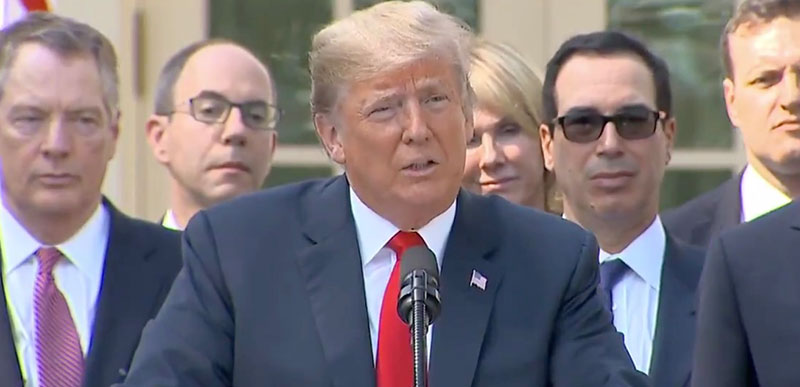Apparently the high steel and aluminum tariffs are still on with Canada, according to Trump this morning. He says he’s not letting that go and said it wasn’t part of this new NUSMCA deal.
Watch:
BREAKING: Trump says he won't drop national security tariffs on Canadian steel and aluminum. #USMCA #NAFTA #cdnpoli pic.twitter.com/lO8yieZIT9
— Michel Boyer (@BoyerMichel) October 1, 2018
According to Trump and his chief negotiator, Lighthizer, they see these national security tariffs and this new trade deal as two different issues.
In case Trump wasn’t clear in the video above, CNN noted this in their write up this morning on the trade deal:
One big question is how the three countries will resolve disputes over US tariffs on steel and aluminum imports from Canada and Mexico.
For now, that part, along with retaliatory tariffs countries have imposed, were left out of the deal.
That piece will have to be negotiated separately, senior administration officials said.
I really thought this deal would do away with the high tariffs, especially considering that it is what brought them to the table.
And it sounds like Trump doesn’t to let them go at all because of how it’s protecting the car industry here.
What that means for this deal passing Congress, I don’t know.
Here’s more from CNN’s article on the deal:
In a win for the United States, USMCA will open up some of Canada’s dairy market to US farmers. The issue was a big sticking point between the two negotiating teams.
Under the original NAFTA, Canada limited how much milk, cheese and other dairy products could come in from the United States.
But under the updated agreement, Canada will set new quotas for the United States. It will increase market access for US dairy, poultry and eggs. In return, the United States will allow more Canadian dairy, peanuts and peanut products, and a limited amount of sugar to cross the border, according to a document from US Trade Representative’s Office.
Canada has also agreed to end a system that had kept the price of some milk products, including milk protein, low. This change will also allow more US dairy products to enter the Canadian market.
The new deal will require more of a vehicle’s parts to be made in North America in order for the car to be free from tariffs.
It requires that 75% of the parts must be made in Canada, Mexico or the United States, about 12 percentage points higher than under the original NAFTA.
The provision will help keep the production of car parts in the United States and bring back some production that moved abroad, the USTR said.
Ford Motor Company applauded the agreement because it will “support an integrated, globally competitive automotive business in North America
And here’s their summary of how it helps the American worker:
The new trade agreement aims to support American workers in several ways.
Most notably, it requires that 40% to 45% of car and truck parts be made by workers earning at least $16 an hour. The goal is to level the playing field between American and Mexican auto workers and to incentivize manufacturers to build more in the United States. One of the main criticisms of NAFTA is that it prompted American car makers to shift production south of the border, where workers earn much less than their US counterparts.
The deal also mandates that 75% of a vehicle’s parts must be made in North America, up from the current 62.5% rule. The Trump administration argues that this will help incentivize billions in new auto sector production in the US.
Also, Mexico has committed to recognize workers’ right to collectively bargain, and the three countries agreed to enforce rights recognized by the International Labor Organization.
All of that said, Jim Pethokoukis, who we’ve quoted in the past regarding monthly unemployment reports, says he doesn’t believe this new deal is all that much better than the original NAFTA agreement. You can read what he has to say here.

